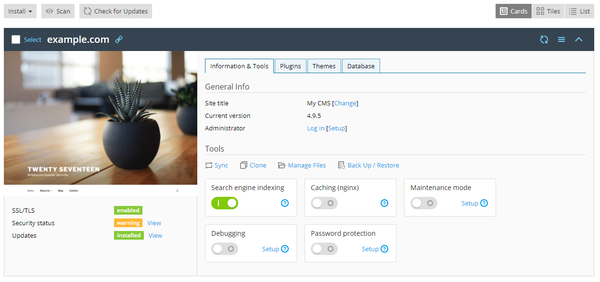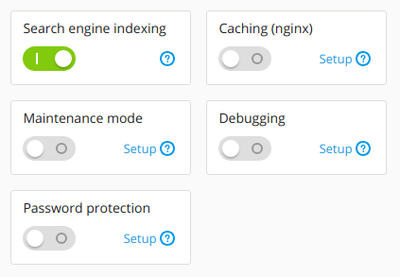WordPress Toolkit/Manage WordPress
Manage Wordpress
The individual cards will contain a screenshot and a number of controls that give you easy access to frequently used tools. The screenshot is real time and should reflect the current home page of your website. If you click the screenshot of the website, the Open Site button appears. Click the button to open the website in a new browser tab.
General Information
In the “General Info” section, you see the WordPress website’s title and its WordPress version. Here you can:
- Click “Change” next to the default “My CMS” title to give your website a custom name.
- Click “Log in” to log in to WordPress as an administrator.
- Click “Setup” next to “Log in” to change general WordPress settings.
Security
WordPress development is frequently attacked by hackers. To help prevent compromises the Toolkit analyzes how safe your instance is. After analyzing your site you’ll be able to see the result below the screenshot of the website:
If you see “warning” or “danger” next to one of these aspects, click “View” and fix it.
To secure your WordPress Website Click Here
Tools
In the “Tools” section, click to access the following WordPress Toolkit features:
- Sync to synchronize the content of your website with another one. More
- Clone to make a full copy of your website. More
- Manage Files to manage the website’s files in File Manager.
- Back Up/Restore to create a backup of your website and restore it if necessary.
The controls below give you easy access to the following settings and tools:
- Search engine indexing shows your website in search results of search engines.
- Caching (nginx) speeds up the website load time and reduces server load.
- Debugging helps you debug a website that is not ready for viewing and being tested or developed.
- Maintenance mode hides your website’s content from visitors. More
- Password Protection specifies the password you will use to log in to WordPress from Plesk.
- On the remaining three tabs you can manage the instance’s plugins, themes, and change the database username and password.
Removing and Detaching Instances
You can detach a synced WordPress instances that you do not want to manage in WordPress Toolkit. Detaching does not remove the instance, merely hides it from WordPress Toolkit.
- A detached instance will be attached to WordPress Toolkit again after you scan for WordPress instances.
- You can detach WordPress instances individually or multiple instances at a time.
To detach WordPress instances
- To to WordPress, choose one or more instances you want to detach, and then click the
 button (to detach an individual instance) or click Detach (to detach multiple instances).
button (to detach an individual instance) or click Detach (to detach multiple instances). - Click Detach.
To remove WordPress instances
- Go to WordPress, choose one or more instances you want to delete, and then click the
 button (to remove an individual instance) or click Remove (to remove multiple instances).
button (to remove an individual instance) or click Remove (to remove multiple instances). - Click Remove.
- Unlike detaching, removing completely deletes a WordPress instance. You can remove WordPress instances individually or multiple instances at a time.
Search Engine Indexing and Debugging
By default, a WordPress website is shown in search engines. If your website is not yet ready for public viewing, switch off Search engine indexing.
If you are installing WordPress for testing or development, you can enable Debugging to automatically find and fix errors in the website code. To do so:
- Click "Setup" next to “Debugging”
- Select the WordPress debugging tools you want to activate
- Click OK.




